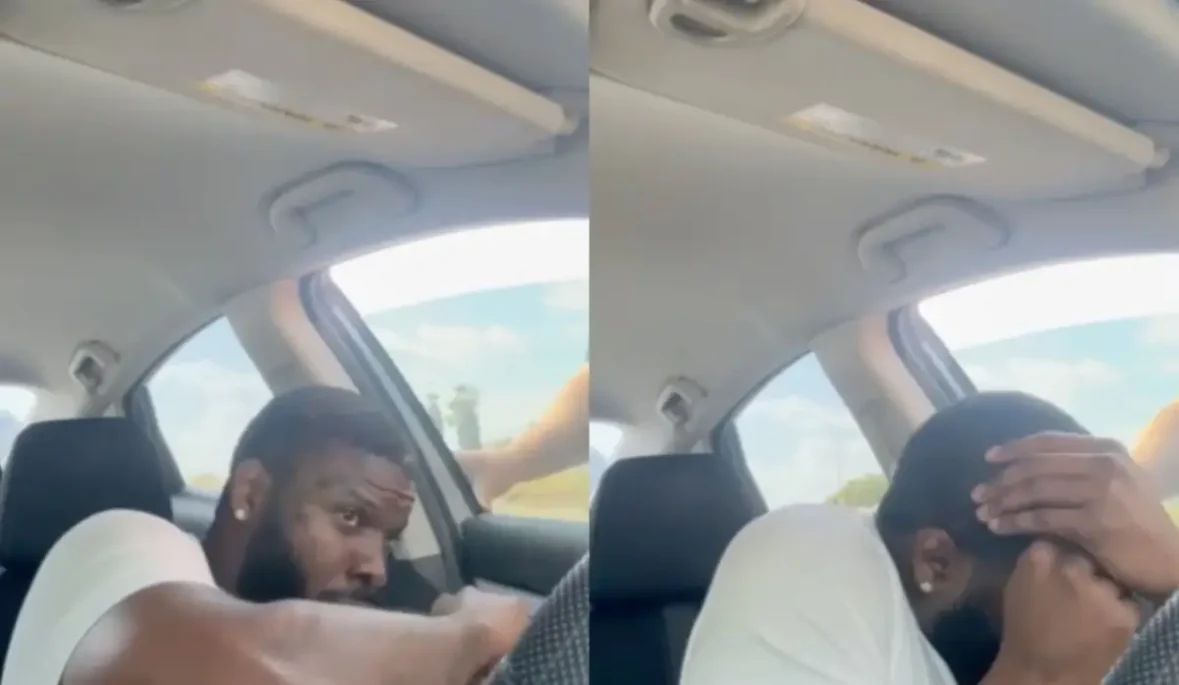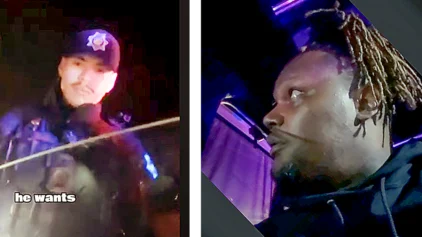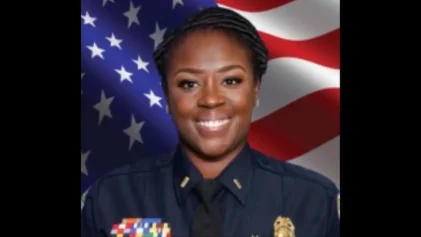Nicholas Hoskins, a 31-year-old Black man from San Diego, spent eight years in prison on a false conviction before the California Supreme Court overturned his conviction for lack of evidence and set him free.
But since his release in February 2023, he has been pulled over several times by San Diego police over minor infractions like a broken tail light, tinted windows and rolling through a stop sign.
It was the latest stop in May for rolling through a stop sign that resulted in police shattering his passenger side window after he refused to step out of the car to allow them to search it for weapons.

Hoskins, who was on his way to pick up his son at a bus stop, repeatedly asked police what probable cause they had to search his vehicle without consent, but they refused to answer his question, forcing him out of the car and handcuffing him.
Police searched the car and found no weapons but transported Hoskins to the police department before releasing him with a citation for resisting arrest. He ended up paying a thousand dollars to get his car back from the impound and to replace the broken window. And his 12-year-old son was forced to wait at the bus stop for two hours without knowing what had happened to his father because the cops had seized his phone.
Hoskins has now retained an attorney and is planning on filing a lawsuit.
“It’s kind of demeaning. Emasculating. Sometimes I feel like I’m not a man,” Hoskins said in an interview with NBC San Diego.
Driving while Black
Police will never admit it, but multiple studies and investigations over several decades show that police across the country tend to target Black drivers at a much higher rate than white or Hispanic drivers for minor traffic infractions.
The latest investigation was conducted by NBC San Diego in its article about Hoskins. The article looked at 666,406 traffic stops conducted by San Diego police during a five-year period from 2019 to 2023, determining that Black people made up 22.5 percent of all traffic stops despite making up only 6 percent of the city’s population.
The investigation also determined that 30 percent of traffic stops involving Black people result in police searching their car, compared to 23 percent for Hispanics and 19 percent for white people.
Nevertheless, police found guns, drugs, alcohol and stolen property in 25 percent of the searches conducted on Black, Hispanic and white people, the investigation revealed.
The conversation between Hoskins and San Diego police went as follows after he was ordered to step out of the car:
Hoskins: “I have 15 minutes to go get my son. He’s getting dropped off at the bus stop at 4:30.”
Officer: “Nicholas, I’m going to open the door. You’re going to undo your seatbelt for me. OK? You’re an adult; I want you to go with the program here. I don’t want to have to…”
Hoskins: “What is the probable cause for a search?”
Officer: “Unlock the door for me.”
Hoskins: “What is the probable cause for a search?”
Officer: “Nicholas, unlock the car.”
Hoskins: “What is the probable cause for a search?”
A cop then told him he was going to smash his window.
Officer: “This doesn’t need to happen, man.”
Hoskins: “It doesn’t need to happen, you guys don’t need to search me. I’m about to go pick up my son. I’m a law-abiding citizen. I’m a tax-paying citizen. I’m not on paperwork or parole. I’m not doing anything wrong!”
Officer: “OK, I’m breaking your window.”
False Conviction
Hoskins told NBC San Diego that he was a “stupid teenager” trying to look cool and attract girls when he posted photos of himself on Facebook throwing up gang signs.
“Everybody did it. Almost every house party,” Hoskins told NBC San Diego. “I was a stupid, stupid teenager, is all I can say. I was an ignorant, stupid teenager.”
He would also post lyrics to rap songs on Facebook celebrating murder, which, along with the photos, were used by the jury as evidence to convict him of conspiracy to commit murder. He was sentenced to 25 years to life in prison.
He spent eight years in prison, where he said he attempted to take his own life on at least two occasions before the California Supreme Court overturned his conviction after justices unanimously agreed there was no direct evidence tying him to murder.
According to the Supreme Court decision:
Absent proof of intent to play some role in achieving the conspiracy’s unlawful goals, neither being a cheerleader nor passively accepting the benefits of others’ unlawful activities constitutes participation in a conspiracy. And the Attorney General fails to point to evidence showing that Hoskins intended the posts to facilitate murder. There is no evidence in any of Hoskins’s posts of a plan to participate in any of the shootings that constituted the object of the conspiracy, nor is there evidence that such posts were directed to any alleged coconspirators
Since then, he has been trying to get his life back on track and is planning to attend a trade school next month to learn how to become a carpenter or welder.
But he is tired of being treated like a violent criminal when there is no evidence or probable cause to indicate he is a violent criminal offender.
San Diego Police Capt. Jeffrey Jordon told NBC San Diego that the reason for the disparity in traffic stops is that police are following orders from elected officials.
“Again, we’re going to police the way that we’re directed,” he said. “The way our community directs us. The way elected officials are directing us.”


